Hello everyone!
My first thread here - as a total newbie I am hoping to get some advice on smaller fullrange drivers in general and line array implementation spcifically.
So - I´ve gathered a couple of different drivers for testing before deciding which to use for a build.
Line up for now is:
- Aurasound neo NS3, 16 ohm version. In a buyers rage I accidentally ordered 60 of these - so there will be a line of these anyhow.
- so there will be a line of these anyhow.
- Visaton FRS-8M
- Faital Pro 3FE20 (Neo)
- Faital Pro 3FE25 (Ferro)
- Sica 3,5 L 1 SL
- Vifa TC9 - 8 ohm
- Vifa TG9 - 8 ohm
Perhaps coming into the mix - Fostex FE83EN and FF85WK
Any other no-brainers I have forgotten?
Now to my question:
I have built a test-baffle with exchangable loudspeaker mounting plate so that every different pair will be tried in same type of baffle.
They will be judged sonically from how they sound after a couple of hundred hours in this baffle. They will be highpassed to a Beyma Liberty-8 in a backloaded horn at whetever frequency I decide upon or will be adviced to try. Probably going to start at about 300 Hz.
But I have absolutely no knowledge about how I go about measuring the drivers. I bought this - Roland UA-55 Quad-Capture B-Stock - Thomann Cyberstore Sverige
and this to use with it - Behringer ECM8000 - Thomann Cyberstore Sverige
Where do I find literature, articles or information on how to measure these drivers accordingly? Just so I can get started and get on with some software to start to figure out how to use the data.
Regards
Pontus
My first thread here - as a total newbie I am hoping to get some advice on smaller fullrange drivers in general and line array implementation spcifically.
So - I´ve gathered a couple of different drivers for testing before deciding which to use for a build.
Line up for now is:
- Aurasound neo NS3, 16 ohm version. In a buyers rage I accidentally ordered 60 of these
 - so there will be a line of these anyhow.
- so there will be a line of these anyhow.- Visaton FRS-8M
- Faital Pro 3FE20 (Neo)
- Faital Pro 3FE25 (Ferro)
- Sica 3,5 L 1 SL
- Vifa TC9 - 8 ohm
- Vifa TG9 - 8 ohm
Perhaps coming into the mix - Fostex FE83EN and FF85WK
Any other no-brainers I have forgotten?
Now to my question:
I have built a test-baffle with exchangable loudspeaker mounting plate so that every different pair will be tried in same type of baffle.
They will be judged sonically from how they sound after a couple of hundred hours in this baffle. They will be highpassed to a Beyma Liberty-8 in a backloaded horn at whetever frequency I decide upon or will be adviced to try. Probably going to start at about 300 Hz.
But I have absolutely no knowledge about how I go about measuring the drivers. I bought this - Roland UA-55 Quad-Capture B-Stock - Thomann Cyberstore Sverige
and this to use with it - Behringer ECM8000 - Thomann Cyberstore Sverige
Where do I find literature, articles or information on how to measure these drivers accordingly? Just so I can get started and get on with some software to start to figure out how to use the data.
Regards
Pontus
Good luck with the measurements. Not sure why, but I never got into measurements? I just buy what captures my imagination, build and listen. If it sounds bad and the driver has no potential for me and my taste than I box it up and put it on the shelf... If I like something about it but the project comes out poorly, I try something else. With the drivers you list, I'd listen to them all and select the ones that sound best to me. Then maybe measure them to see what the chart looks like. But regardless of the chart, I'd listen to the one that sounds best to me. Enjoy the process!
Thank you Godzilla. I hope the process will be as enlightening as I think.
The only real reason to get som insight into measuring for me is that I want to be sure to get it right with the electronic crossover. And be able to somewhat understand what my fiddling results in sonically. Ha - we´ll see how that last part comes out.
By the way - I found an article from Stereophile written by Atkinson on measurements. Maybe that will be a good place to start.
I´ll post some pics of the test baffle and drivers. Pics always to seem to get the know-how out of the people who has it.
Also - my take on this build is somewhat similar to yours Godzilla - something captures my imagination and I want to try it. This time linearrays and fullrangers.
/pontus
The only real reason to get som insight into measuring for me is that I want to be sure to get it right with the electronic crossover. And be able to somewhat understand what my fiddling results in sonically. Ha - we´ll see how that last part comes out.
By the way - I found an article from Stereophile written by Atkinson on measurements. Maybe that will be a good place to start.
I´ll post some pics of the test baffle and drivers. Pics always to seem to get the know-how out of the people who has it.
Also - my take on this build is somewhat similar to yours Godzilla - something captures my imagination and I want to try it. This time linearrays and fullrangers.
/pontus
Hi Pnotus,
For software, I use HolmImpulse and REW. REW is more powerful, but HolmImpulse is very easy to use, at least it is for me cause it's what I've always used. rpb and I put this little guide together: A HOLM starter guide
Personally I try and do my measurements outside to reduce the room effects. It's important to measure the room effects, but not when comparing drivers. Otherwise you'll swamp the driver with the room everytime.
There are plenty of online forum descriptions of how to test, but it's a good idea to get D'Appolito's Testing Loudspeakers book.
I use to just take a quick and dirty on axis frequency response. But this is a very small piece of the puzzle. Make sure you get as much data as you can or need for your purposes. Sometimes all I need is a quick on axis. But if comparing drivers, you need much more. Something to keep in mind. It seems everytime I do measurements and design, I learn more about what they mean in terms of what I hear. Keep an open mind. If one of the drivers sounds bad but measures good, you missed something.
For software, I use HolmImpulse and REW. REW is more powerful, but HolmImpulse is very easy to use, at least it is for me cause it's what I've always used. rpb and I put this little guide together: A HOLM starter guide
Personally I try and do my measurements outside to reduce the room effects. It's important to measure the room effects, but not when comparing drivers. Otherwise you'll swamp the driver with the room everytime.
There are plenty of online forum descriptions of how to test, but it's a good idea to get D'Appolito's Testing Loudspeakers book.
I use to just take a quick and dirty on axis frequency response. But this is a very small piece of the puzzle. Make sure you get as much data as you can or need for your purposes. Sometimes all I need is a quick on axis. But if comparing drivers, you need much more. Something to keep in mind. It seems everytime I do measurements and design, I learn more about what they mean in terms of what I hear. Keep an open mind. If one of the drivers sounds bad but measures good, you missed something.
Get this.
Dayton Audio OmniMic V2 Precision Audio Measurement System 390-792
It explains how to take and understand all the measurements within the program.
Also, it comes with a calibrated mic. and it's a simple USB interface.
This is what I use, it's accurate and simple.
Get this.
http://www.parts-express.com/pe/showdetl.cfm?partnumber=390-806
This is for impedance and TS parameters.
Very simple, also easy USB interface.
I vote for the vifa tc9.....
I used that driver in this build.
http://www.diyaudio.com/forums/multi-way/217096-event-horizon-ambiopole.html
And I can tell you, it's glorious
Dayton Audio OmniMic V2 Precision Audio Measurement System 390-792
It explains how to take and understand all the measurements within the program.
Also, it comes with a calibrated mic. and it's a simple USB interface.
This is what I use, it's accurate and simple.
Get this.
http://www.parts-express.com/pe/showdetl.cfm?partnumber=390-806
This is for impedance and TS parameters.
Very simple, also easy USB interface.
I vote for the vifa tc9.....
I used that driver in this build.
http://www.diyaudio.com/forums/multi-way/217096-event-horizon-ambiopole.html
And I can tell you, it's glorious
Last edited:
For individual driver measurements or a conventional system measurements, you can use any of the Impulse capture software like Holm, ARTA or Sound Easy. Arta has a LIMP utility that measures TS and impedance of the driver/system. This option makes DATS useless and I'd stay away from it unless you have an extra $100 to give to PE.
Holm is free but somewhat limited. ARTA is free without "save option" and has everything you need to look in to the driver performance. Sound Easy is $300 and has a few powerful algorithms build in, including crossover design cad, close in capabilities to LinearX crossover design workshop.
Line arrays are difficult to measure with Impulse capture and I'd recommended using an RTA software instead.
All and all, you can use impulse to look in to the drivers performance and RTA to look in to room/speaker interaction and summed frequency response.
"Testing Loudspeakers" by D'Appolito is the recommended reading.
Holm is free but somewhat limited. ARTA is free without "save option" and has everything you need to look in to the driver performance. Sound Easy is $300 and has a few powerful algorithms build in, including crossover design cad, close in capabilities to LinearX crossover design workshop.
Line arrays are difficult to measure with Impulse capture and I'd recommended using an RTA software instead.
All and all, you can use impulse to look in to the drivers performance and RTA to look in to room/speaker interaction and summed frequency response.
"Testing Loudspeakers" by D'Appolito is the recommended reading.
Last edited:
Hi Pnotus,
There has been some great advice given already in terms of measurement, so I won't repeat too much.
I used Speaker Workshop when I was evaluating drivers for my array, and it works well for measuring a single driver in an enclosure. For the actual arrays, I use RTA as R-Carpenter suggests. You'll find the arrays very difficult to measure with an impulse.
Overall, you've got exactly the right idea for choosing a driver. Listen to each one carefully, make good notes, then measure each one and compare. That approach will help you understand what you were hearing without letting the measurements bias your listening impressions. I personally think a driver should both measure well, and sound good independently.
You can read a little more about the arrays I built here:
http://www.diyaudio.com/forums/multi-way/193015-stupid-cheap-line-array-4.html#post2648779
I tested quite a few drivers and ended up with the TC9FD-18-08. It sounded the most balanced and neutral, and it had very good bottom end and some of the smoothest treble I've ever heard from a fullrange.
Sorry to hear about NS3 purchase... I wasn't a big fan
You have a few drivers on your list that I haven't heard, the most promising of which appears to be Faital Pro 3FE25. It looks like a superb little driver with all the right qualities for an array. The C-C spacing is excellent, the response looks very even and extended, the FS is pretty low, the Xmax is reasonable and the efficiency is very very high for a driver that size. I might actually order up a few and give them a listen for fun
Best of luck!
Cheers,
Owen
There has been some great advice given already in terms of measurement, so I won't repeat too much.
I used Speaker Workshop when I was evaluating drivers for my array, and it works well for measuring a single driver in an enclosure. For the actual arrays, I use RTA as R-Carpenter suggests. You'll find the arrays very difficult to measure with an impulse.
Overall, you've got exactly the right idea for choosing a driver. Listen to each one carefully, make good notes, then measure each one and compare. That approach will help you understand what you were hearing without letting the measurements bias your listening impressions. I personally think a driver should both measure well, and sound good independently.
You can read a little more about the arrays I built here:
http://www.diyaudio.com/forums/multi-way/193015-stupid-cheap-line-array-4.html#post2648779
I tested quite a few drivers and ended up with the TC9FD-18-08. It sounded the most balanced and neutral, and it had very good bottom end and some of the smoothest treble I've ever heard from a fullrange.
Sorry to hear about NS3 purchase... I wasn't a big fan
You have a few drivers on your list that I haven't heard, the most promising of which appears to be Faital Pro 3FE25. It looks like a superb little driver with all the right qualities for an array. The C-C spacing is excellent, the response looks very even and extended, the FS is pretty low, the Xmax is reasonable and the efficiency is very very high for a driver that size. I might actually order up a few and give them a listen for fun
Best of luck!
Cheers,
Owen
Attachments
-
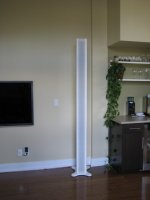 Finished Line Array.JPG209.5 KB · Views: 516
Finished Line Array.JPG209.5 KB · Views: 516 -
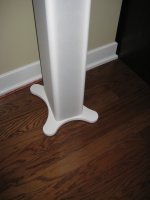 Finished - Painted base and white sock.JPG268.8 KB · Views: 502
Finished - Painted base and white sock.JPG268.8 KB · Views: 502 -
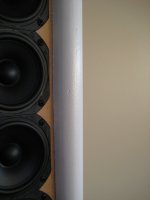 Array Side.jpg228 KB · Views: 489
Array Side.jpg228 KB · Views: 489 -
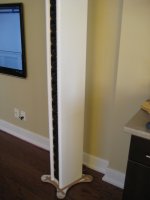 Unpainted base and no sock.JPG214.5 KB · Views: 489
Unpainted base and no sock.JPG214.5 KB · Views: 489 -
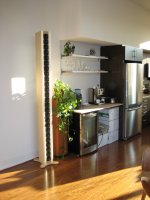 Unfinished.JPG479.7 KB · Views: 490
Unfinished.JPG479.7 KB · Views: 490 -
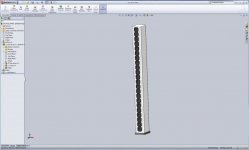 Screenshot - Line Array.jpg73.5 KB · Views: 136
Screenshot - Line Array.jpg73.5 KB · Views: 136 -
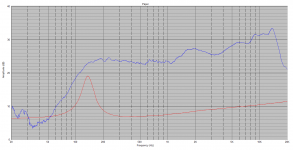 Frequency Response of a single raw driver.png63.3 KB · Views: 120
Frequency Response of a single raw driver.png63.3 KB · Views: 120
Hi Melo,
Thanks! I really like them. the TC9 is a hell of a little driver. Even without factoring in cost it's easily one of the best, but when you consider it can be had for $6.50 in large quantities, it's in a league of it's own.
That reminds me... my overall favourite of all the drivers I tested in terms of sound and measurement was the Fountek FR88EX:
Speaker Building Supplies from Madisound
Unfortunately, at $50 each they were a little too rich for my blood. If price hadn't been a factor though, I would have built with those.
Cheers,
Owen
Thanks! I really like them. the TC9 is a hell of a little driver. Even without factoring in cost it's easily one of the best, but when you consider it can be had for $6.50 in large quantities, it's in a league of it's own.
That reminds me... my overall favourite of all the drivers I tested in terms of sound and measurement was the Fountek FR88EX:
Speaker Building Supplies from Madisound
Unfortunately, at $50 each they were a little too rich for my blood. If price hadn't been a factor though, I would have built with those.
Cheers,
Owen
Yeah, I know it's a great driver.
Check out the build thread I posted above.
Where did you find it for 6.50?
I just gave it a read... very cool stuff!
You've got a lot of surface area to play with there.
Are you sure you've got enough power from the two little Daytons? I've got a clean 225W per channel and the amp still clips before the drivers get ugly. Mind you, I'm probably using much more EQ on the bottom end.
As for the $6.50, it's from PE if you buy 100pcs.
Cheers,
Owen
I just gave it a read... very cool stuff!
You've got a lot of surface area to play with there.
Are you sure you've got enough power from the two little Daytons? I've got a clean 225W per channel and the amp still clips before the drivers get ugly. Mind you, I'm probably using much more EQ on the bottom end.
As for the $6.50, it's from PE if you buy 100pcs.
Cheers,
Owen
Well, it's eq'd for a 4th order LR at 80 hz. Crossed to an H frame 18" OB sub.
Did you call PE to get that price?
Damn, I would have ordered 100 if I knew! AAAAARRRRGGGG!!!!
I just added 100 to the cart and the cost was 1070.00?
Last edited:
If you build one with 50 speakers/array you could go directly to the manufacturer.
Fountek Fr89ex 3 Inch Full Range Speaker Driver - Buy Full Range Driver,3 Inch Driver,Fountek Driver Product on Alibaba.com
I tried a fountek fr89ex in a tapered transmission line and it is really nice.
Products_Fountek Electronics Co.,Ltd
Klippel test on that driver can be found here:
DIYMA Car Audio Forum
You have to register to that forum to read it.
Their new 2" looks nice if you want to minimise cc.
Fountek Fr89ex 3 Inch Full Range Speaker Driver - Buy Full Range Driver,3 Inch Driver,Fountek Driver Product on Alibaba.com
I tried a fountek fr89ex in a tapered transmission line and it is really nice.
Products_Fountek Electronics Co.,Ltd
Klippel test on that driver can be found here:
DIYMA Car Audio Forum
You have to register to that forum to read it.
Their new 2" looks nice if you want to minimise cc.
My two cents: whenever testing a range of drivers, be sure to take room interaction into account. As a test, measure the driver with the baffle in one location of the room, e.g. 2 feet from side wall, three feet from back wall, microphone centered one meter away, and then perform the same measurement but move the baffle (and microphone) a foot further away from one wall. Both measurements will look quite different, with different sets of peaks and dips, because all of the room reflections will have shifted slightly. Or move the microphone various distances away and see how the peaks and valleys change. It is very hard to isolate the actual performance of the speaker from the room interaction. But since you are comparing many drivers, the job will be easier: for example, if every driver measured has a dip in response at 1.5k, you can basically assume that this is a room reflection and not actual performance.
That might be true for RTA, but that is not correct for most speaker measurement programs that use MLS. The whole point of MLS is to remove the influence of the room on your measurements.
The farther you can get from walls and floors, the longer you can set your gate, the better your low frequency resolution will be. MLS is specifically designed to gate the measurement so only the first arrival is used to derive the response.
A properly setup MLS measurement system like Speaker Workshop, Soundeasy (or many others) will measure the same response regardless of the surroundings providing you can meet a basic distance criteria from any adjacent reflective surfaces.
You cannot perform reliable loudspeaker measurements if you're within 2 feet of an adjacent wall as you mention. Doing proper measurements doesn't require a huge space, but you do need to follow some basic guidelines.
Regards,
Owen
The farther you can get from walls and floors, the longer you can set your gate, the better your low frequency resolution will be. MLS is specifically designed to gate the measurement so only the first arrival is used to derive the response.
A properly setup MLS measurement system like Speaker Workshop, Soundeasy (or many others) will measure the same response regardless of the surroundings providing you can meet a basic distance criteria from any adjacent reflective surfaces.
You cannot perform reliable loudspeaker measurements if you're within 2 feet of an adjacent wall as you mention. Doing proper measurements doesn't require a huge space, but you do need to follow some basic guidelines.
Regards,
Owen
Last edited:
+1 OPC.
There are two methodology here. Impulse capture allows to look in to the individual driver performance aspects such as linear and nonlinear distortions, impulse in time and some others. It will also allow semi anechoic measurements of the conventional speaker system, using merging technique. Issue with the line array is the interference between the drivers and resulting mess because of the multiple driver/impulse capture.
RTA look in to the summed up response, including the effect of the room. RTA will also show very clearly high frequency loss, specific to the linear array configurations.
So, both of these methods are very useful, just in their own way.
There are two methodology here. Impulse capture allows to look in to the individual driver performance aspects such as linear and nonlinear distortions, impulse in time and some others. It will also allow semi anechoic measurements of the conventional speaker system, using merging technique. Issue with the line array is the interference between the drivers and resulting mess because of the multiple driver/impulse capture.
RTA look in to the summed up response, including the effect of the room. RTA will also show very clearly high frequency loss, specific to the linear array configurations.
So, both of these methods are very useful, just in their own way.
Hello everyone! Nice to see this interest for my project/projects.
Tuxedo - Thanks for your advice. Your comments suggest that I am not that far of in reasoning around this. Good to know. I´ve been looking at REW as a useful tool. I´ll probably try to learn how to use this SW.
TVRgeek - Thanks! The book is ordered.
Melo - I´ve got some measurement devices, soundcard and mic already. Now it´s just to learn how to use it...
VERY cool build. I have high expectations for the TC9. Your woodworking skills and patience are inspiring.
I´ve been eyeing the DATS. Wonder if anyone here have one for me to take a look at.
R-carpenter - Excellent breakdown of the softwares for a newbie. Thanks!
OPC - Thanks for good general advice, also good to see that I may already have some serious contenders in this group of drivers. Your arrays look great! As a hobby (very!) carpenter I cannot ignore the routing performed to fit your TC9's in the baffle. Nice! Did you use a jig, free hand routing or CNC?
I've had the Faital Neo up in a test baffle before, not as serious as my current but listened to it alot. It sounds nice, can take some punishment and really has a nice treble tone. I´m really curious about it´s Ferro sister.
By the way - I also model my speaker in SolidWorks or Inventor, even Catia V5 if feel that I have time on my hands.
Regarding the NS3's - I guess I can make them sound in some way. Can use them for listening until next pair is finished. They were just too cheap to leave be.
The Founteks look nice but are a bit expensive. They are also round, and have bit larger surround. But I think that 50USD per driver is a bit too much for me.
Ingvar - min synnerlige trevlige högtalarförsäljare/konstruktör. How very nice to meet you here, your continous updates in your thread at Hififorum have been missed the last couple of weeks. But your 21" subs do look nice!
Well - the Beyma's look at me wanting when I enter the workshop so I hope that I can start in a couple of weeks. Work seems to be getting in the way for freetime fun right now. You´ll be the first to know when they are done.
Nisse - Tack för det! If the price is more humane I could atleast get a pair to try out.
Chaz - good advice. I'll try to take these things into consideration. I'm getting curious about the room so it can be useful to see some graphs on different drivers.
I'll post some pics of the test baffles during this weekend to see if I made any fundamental F-ups.
Thanks so much for your shown interest so far.
/Pontus
Tuxedo - Thanks for your advice. Your comments suggest that I am not that far of in reasoning around this. Good to know. I´ve been looking at REW as a useful tool. I´ll probably try to learn how to use this SW.
TVRgeek - Thanks! The book is ordered.
Melo - I´ve got some measurement devices, soundcard and mic already. Now it´s just to learn how to use it...
VERY cool build. I have high expectations for the TC9. Your woodworking skills and patience are inspiring.
I´ve been eyeing the DATS. Wonder if anyone here have one for me to take a look at.
R-carpenter - Excellent breakdown of the softwares for a newbie. Thanks!
OPC - Thanks for good general advice, also good to see that I may already have some serious contenders in this group of drivers. Your arrays look great! As a hobby (very!) carpenter I cannot ignore the routing performed to fit your TC9's in the baffle. Nice! Did you use a jig, free hand routing or CNC?
I've had the Faital Neo up in a test baffle before, not as serious as my current but listened to it alot. It sounds nice, can take some punishment and really has a nice treble tone. I´m really curious about it´s Ferro sister.
By the way - I also model my speaker in SolidWorks or Inventor, even Catia V5 if feel that I have time on my hands.
Regarding the NS3's - I guess I can make them sound in some way. Can use them for listening until next pair is finished. They were just too cheap to leave be.
The Founteks look nice but are a bit expensive. They are also round, and have bit larger surround. But I think that 50USD per driver is a bit too much for me.
Ingvar - min synnerlige trevlige högtalarförsäljare/konstruktör. How very nice to meet you here, your continous updates in your thread at Hififorum have been missed the last couple of weeks. But your 21" subs do look nice!
Well - the Beyma's look at me wanting when I enter the workshop so I hope that I can start in a couple of weeks. Work seems to be getting in the way for freetime fun right now. You´ll be the first to know when they are done.
Nisse - Tack för det! If the price is more humane I could atleast get a pair to try out.
Chaz - good advice. I'll try to take these things into consideration. I'm getting curious about the room so it can be useful to see some graphs on different drivers.
I'll post some pics of the test baffles during this weekend to see if I made any fundamental F-ups.
Thanks so much for your shown interest so far.
/Pontus
- Status
- This old topic is closed. If you want to reopen this topic, contact a moderator using the "Report Post" button.
- Home
- Loudspeakers
- Full Range
- How to test a range of fullrange drivers?